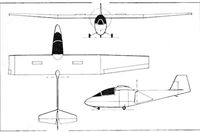
M.Hardy. Gliders & Sailplanes of the world
Brditschka HB-3
Designed by Heinz W. Brditschka and built by his firm at Linz in Austria, the HB-3B is a single-seater cantilever high wing monoplane distinguished by a pusher propeller rotating in a triangular cut-out in the glassfibre-covered tubular steel framework carrying the tail. This consists of two steel tubes, the upper one running through the centre of the propeller and the lower one from the bottom of the fuselage just under the propeller disc; the forward fuselage containing the engine and cockpit is likewise a steel tube framework covered with glassfibre. The HB-3 uses the basic wing design of the Krahe sailplane designed in Germany by Ing Fritz Raab; the wing is a conventional all-wood structure of red pine, spruce and birch ply, with spoilers in the upper surfaces; no flaps or trim tabs are fitted. Design of the HB-3 started in 1968 and the first of three prototypes made its maiden flight on 23 June 1971, followed by the second on 5 June 1972 and the third on 28 July 1972. Nine production HB-3s had been completed by early 1976, but production ended that year. Brditschka also converted an HB-3 airframe in 1973 to have electric power, in which form it was known as the Militky MB-E1; Fred Militky, who designed the installation of the 13hp Bosch electric motor that replaced the piston engine, was an engineer with the Graupner model-building company, and used his experience with electrically-powered radio-controlled models to produce this first electric motor glider. This made what is claimed to be the first ever manned electric-powered flight on 21 October 1973. The HB-3's standard powerplant was a 41 hp Rotax 642 two-stroke 'flat twin' mounted aft of the cockpit and driving a Hoffman two-bladed fixed-pitch propeller via a belt; the fuel used is a 75/25% petrol and oil mixture, and there is a single fuel tank in the fuselage and an aluminium tank in the wing centre-section, which together provide a total capacity of 8.15 Imp gallons. The tail unit is of all-wood construction, with wire bracing from the fin to the centre section trailing edges; the fixed-incidence tailplane has a trim tab in the starboard elevator. The fixed nosewheel undercarriage has glassfibre legs which provide all the necessary shock absorption without the need for separate shock absorbers. The main wheels have Tost mechanical brakes. The pilot sits under a large cockpit canopy that hinges to open sideways to starboard; there is a small baggage space behind his seat and a ram air intake in the nose is provided for cabin ventilation.
Data: HB-3B
Span: 39 ft 4 1/2 in
Length: 22 ft 11 3/4 in
Height: 9 ft 8 in
Wing area: 153.1 sqft
Aspect ratio: 10.11
Empty weight: 573 lb
Max weight: 837 lb
Max speed: 108 mph (in smooth air, power off)
Max cruising speed: 99 mph
Min sinking speed: 3.77 ft/sec at 45.5 mph
Best glide ratio: 20:1 at 50 mph
Take-off run to 50ft: 755 ft
Range with max fuel: 341 miles
Brditschka HB-21
The HB-21, which first flew in 1973, is basically an enlarged version of the HB-3 with an increased wing span and a lengthened forward fuselage seating two people in tandem under a long three-piece cockpit canopy hinged to open sideways. The HB-3's basic configuration of high wings and a pusher propeller rotating in a cut-out portion of the fuselage is retained. Construction is very similar to the HB-3, the fabric-covered three-piece wooden wings being of birch ply with laminated beech spars; they now have Wortmann aerofoil sections and there are spoilers in the upper surfaces. The fuselage is a steel tube framework covered with glassfibre, and the wooden tail unit has a fixed-incidence tailplane and fabric-covered control surfaces. The fixed nosewheel undercarriage has Tost mechanical brakes on the main wheels. Four prototypes were built which included both the HB-21R with a 41 hp Rotax 642 two-stroke engine like the HB-3, and the HB-21L with a 65hp Volkswagen(VW)-Westermayer 1600G 'flat four' motor, the latter being the principal version; both powerplants drove a Hoffman HO 14-175 B 117 LD two-blade fixed-pitch propeller, and both versions have an 11.9 Imp gallon aluminium fuel tank in the wing. Certification of the HB-21 was granted in February 1978, and a year later 15 had been built.
Data: HB-21L
Span: 53 ft 3 1/2 in
Length: 25 ft 11 in
Height: 8 ft 6 1/4 in
Wing area: 204.3 sq ft
Aspect ratio: 13.89
Empty weight: 1,102 lb
Max weight: 1,565 lb
Max speed: 124 mph (in smooth air, power off)
Max cruising speed: 99 mph
Min sinking speed: 3.94 ft/sec at 52 mph
Best glide ratio: 24-26:1 at 65 mph
Max rate of climb: 650 ft/min at sea level
Take-off run: 330 ft
Range with max fuel: 497 miles
- M.Hardy. Gliders & Sailplanes of the world
Фотографии
-
Jane's All the World Aircraft 1976 / 03 - Sailplanes
Регистрационный номер: OE-9061 Brditschka HB-3R single-seat powered sailplane
-
Jane's All the World Aircraft 1976 / 03 - Sailplanes
Регистрационный номер: OE-9063 Brditschka HB-21 two-seat powered sailplane developed from the HB-3
-
Jane's All the World Aircraft 1975 / 03 - Sailplanes
Регистрационный номер: OE-9023 [2] Militky MB-E1 electric-powered aircraft, modified from an Austrian-built HB-3 sailplane
-
Jane's All the World Aircraft 1976 / 03 - Sailplanes
Регистрационный номер: OE-9023 [2] The silent Militky Brditschka MB-E1 during its 9-minute maiden flight on October 21, 1973. Power is provided by a standard Bosch. 10kw electric motor and Varta batteries, giving 13 h.p.
-
Jane's All the World Aircraft 1974 / 03 - Sailplanes
Austria-Krahe single-seat powered sailplane (40 hp TR-II engine)
- Фотографии





